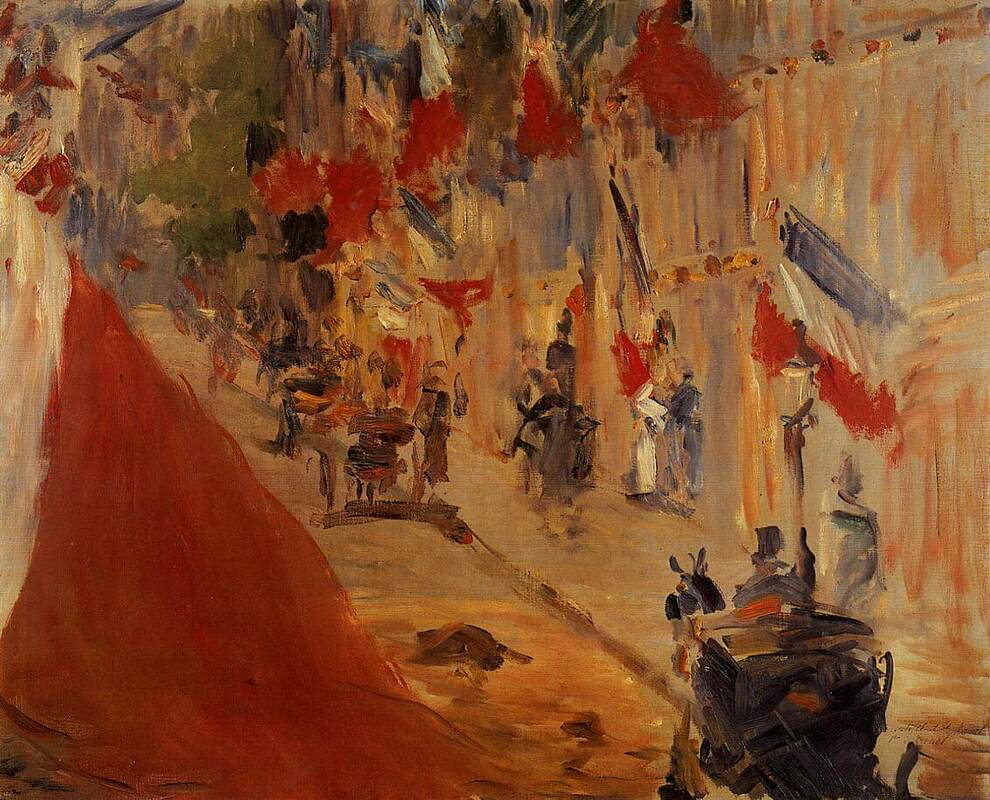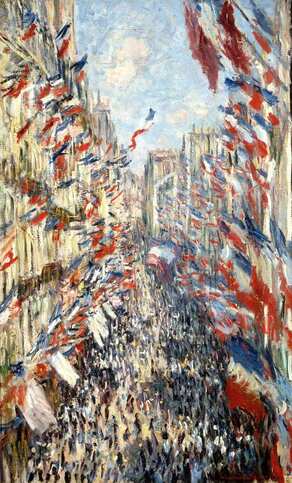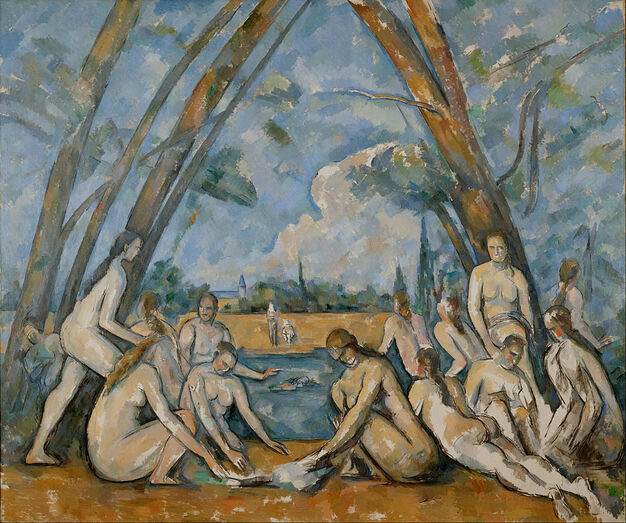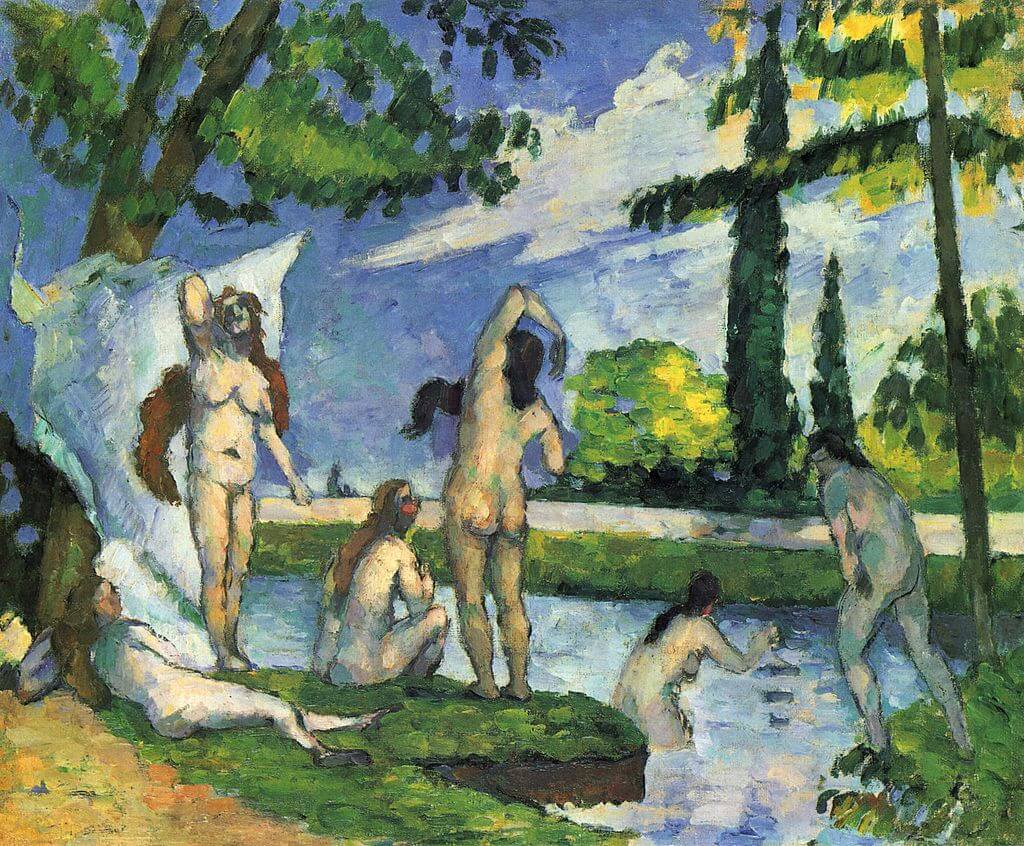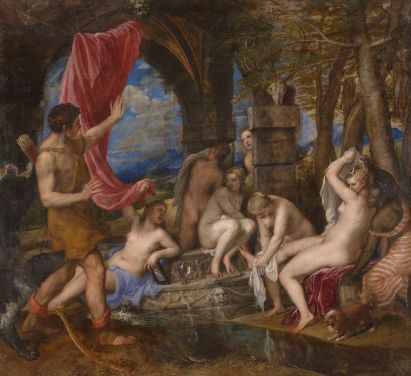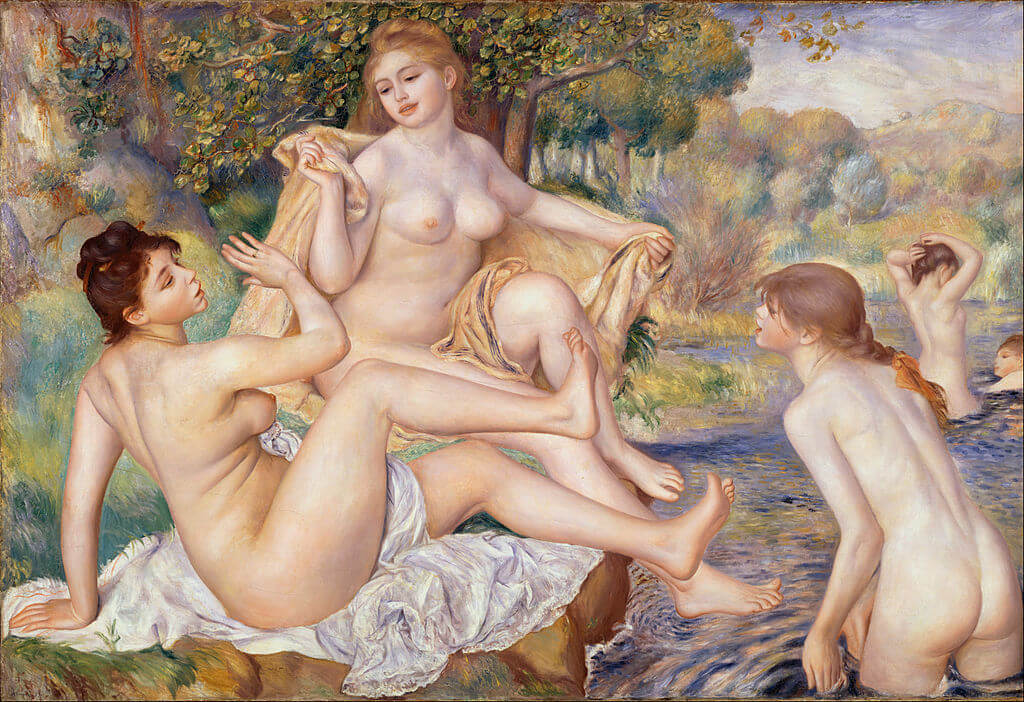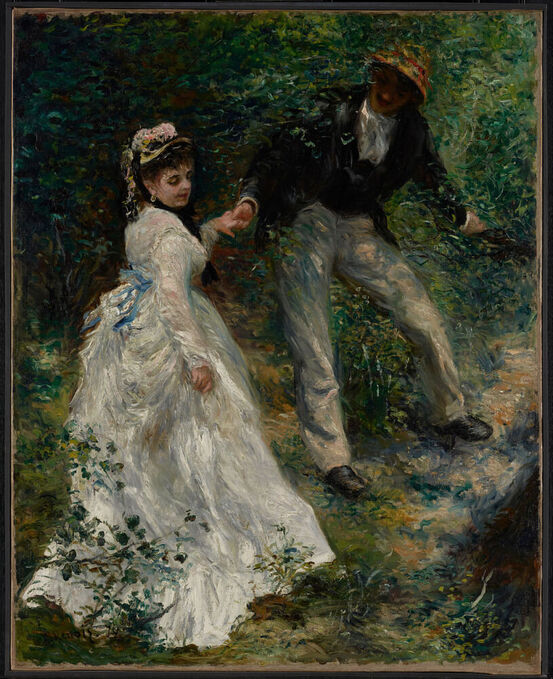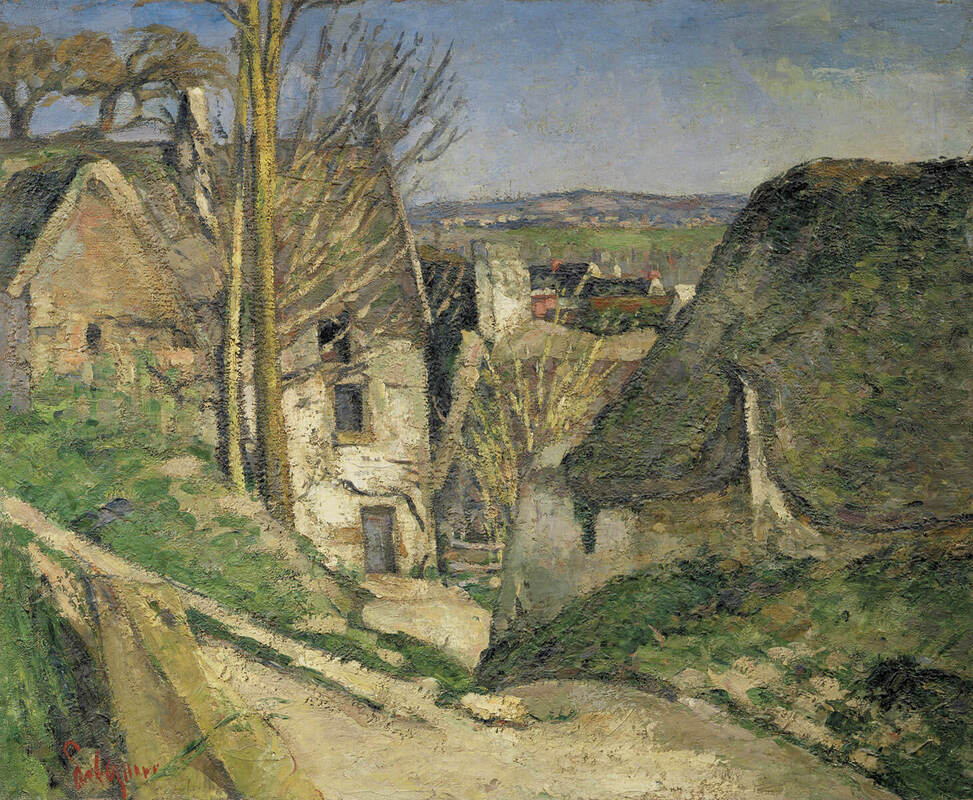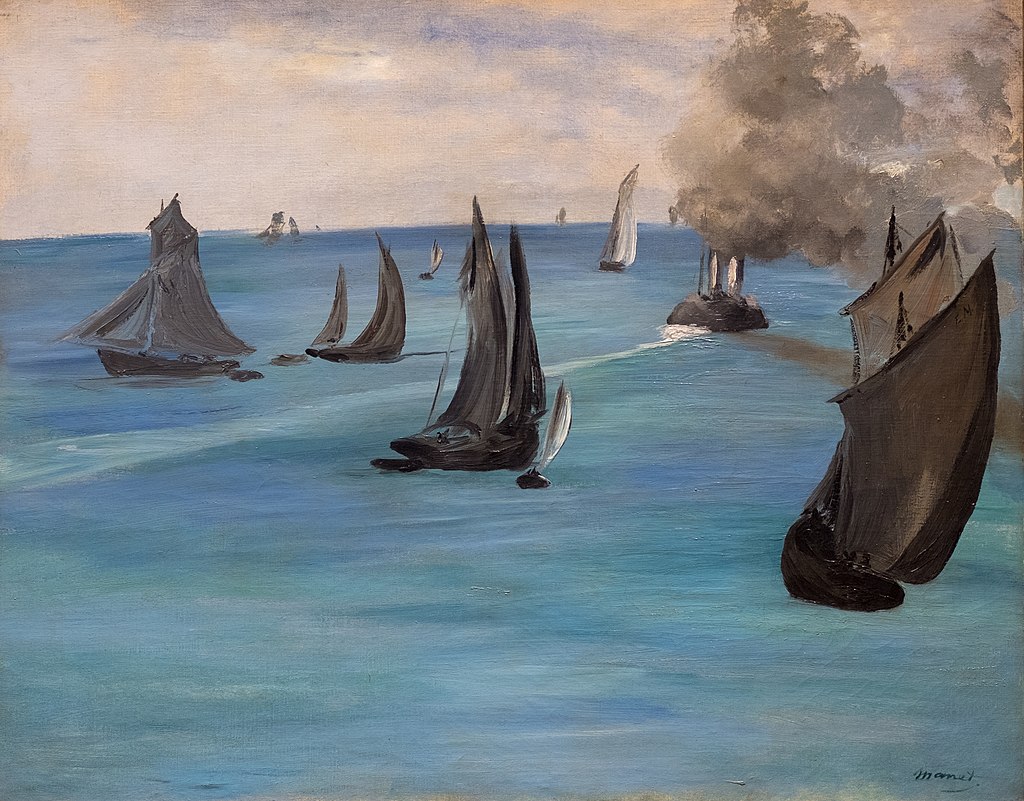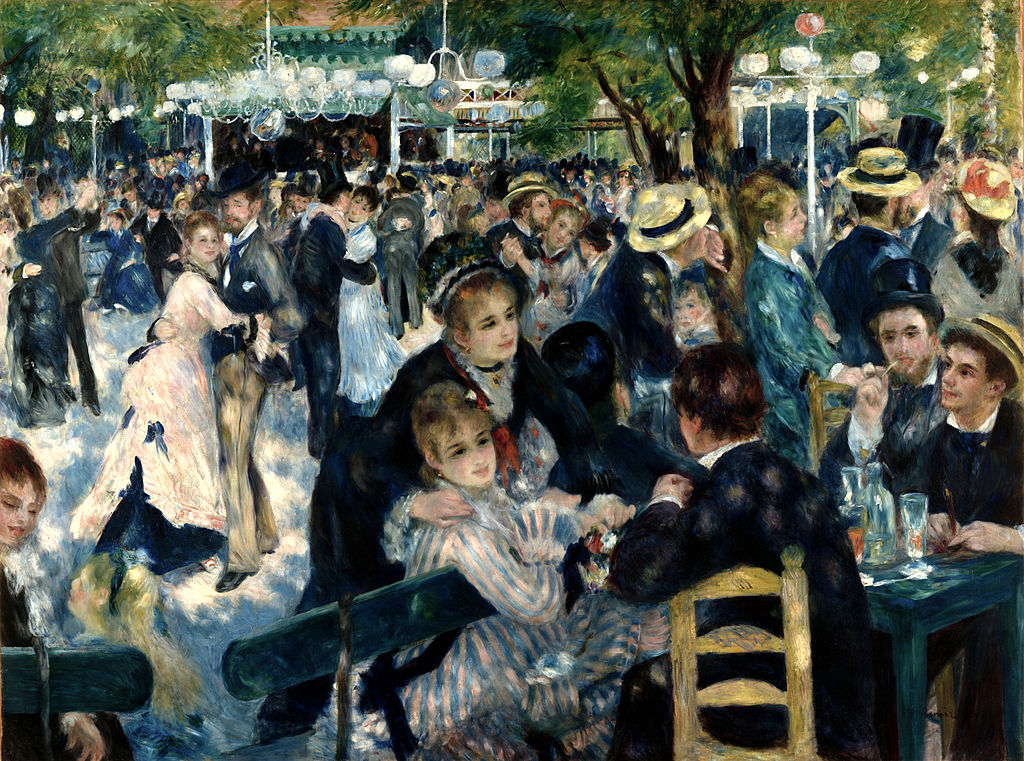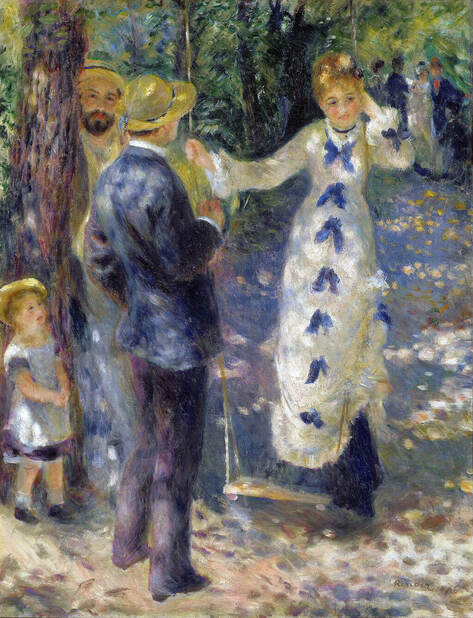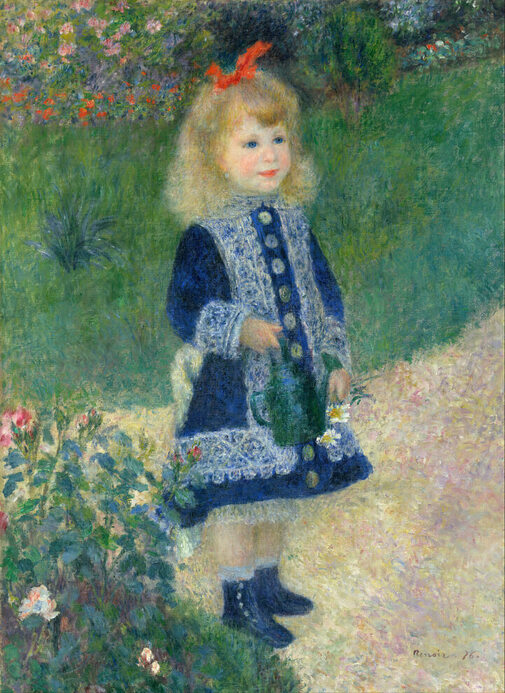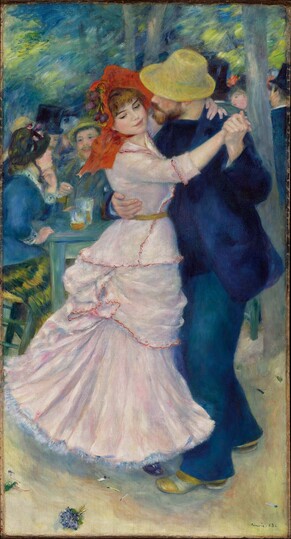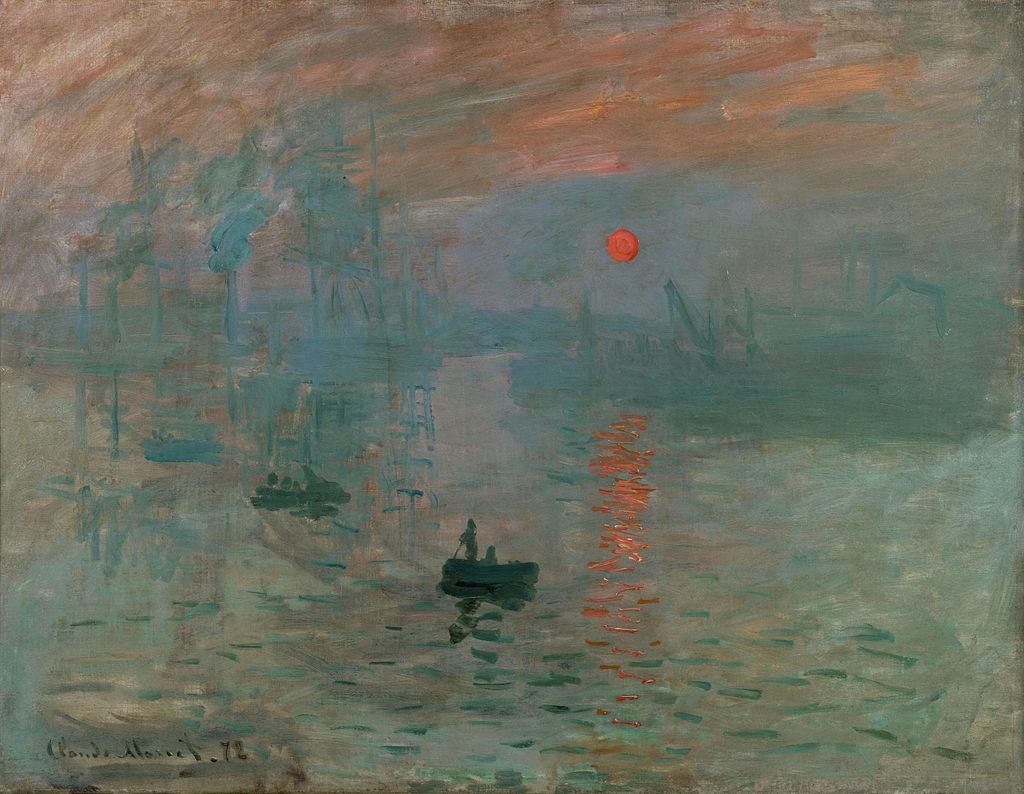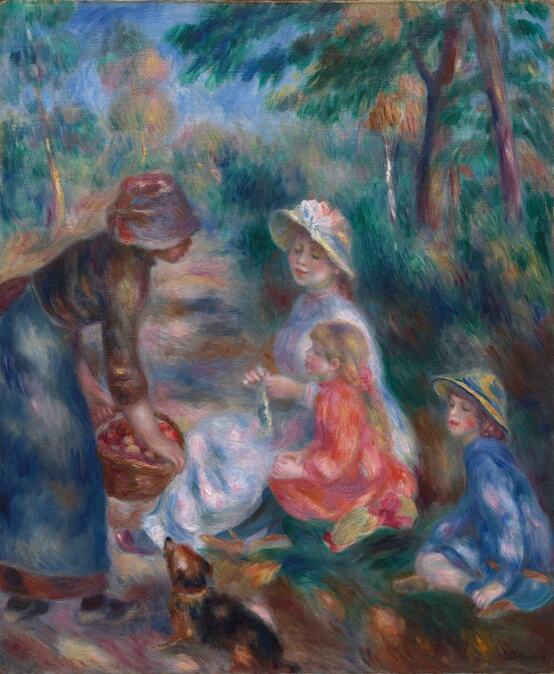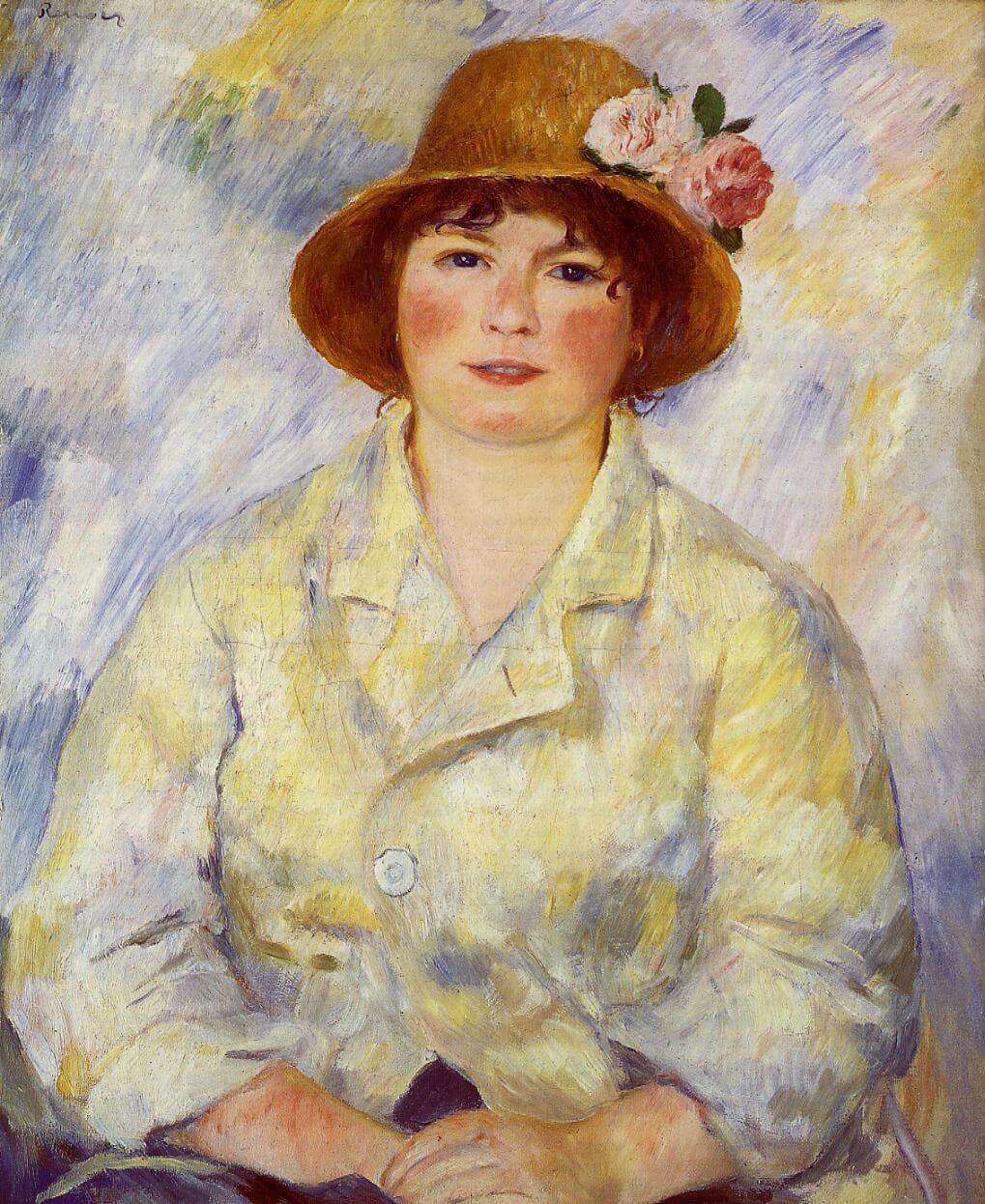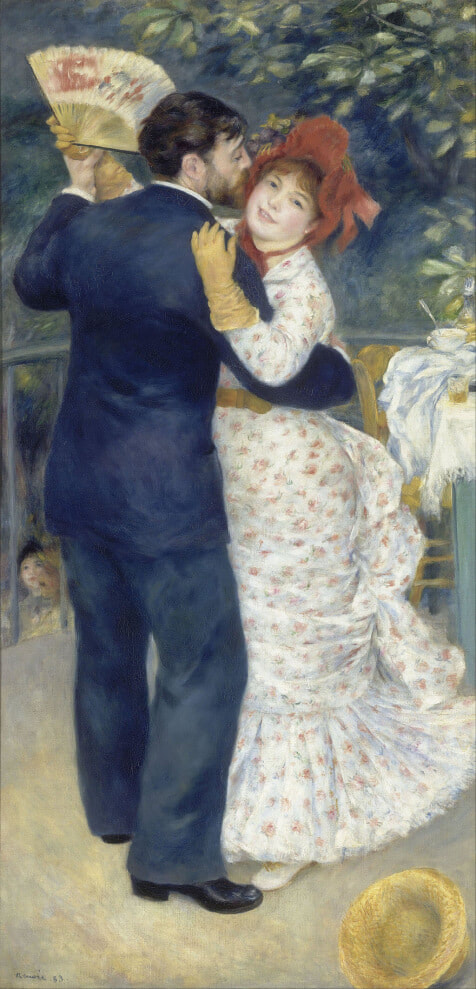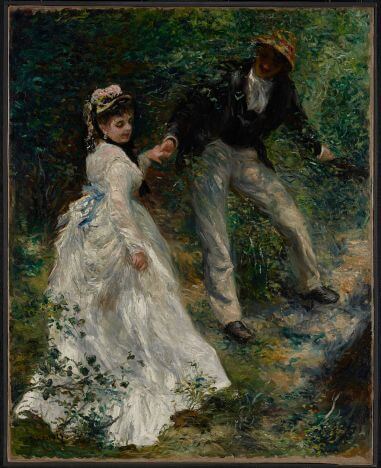|
Where? Gallery 201 at The Art Institute of Chicago
When? 1877 What do you see? A busy, rainy street near the Saint-Lazare station in Paris. The canvas is divided in half by an axis, a tall green streetlamp. Walking on the right of it, in the foreground, are a couple dressed in the latest Parisian fashion. As they walk arm in arm beneath an umbrella, looking off to the left side of the canvas, a stranger passes them with his back to the viewer. Judging by the young woman’s brown dress and diamond earring, the pair are likely of the upper class. The men in the middle ground appear to be dressed in a similar fashion. Further down the canvas are some traces of the working class. Behind the man’s umbrella, a painter dressed in white carries a ladder across the street. Behind the woman, a baker looks out her window. Two carriage drivers can be seen on the left side of the street lamp.
Backstory: Exhibited at the Third Impressionist Exhibition in 1877, Paris Street; Rainy Day was celebrated by many. The natural scene of a real Parisian street painted in a realistic fashion calls back to Caillebotte’s interest in photography. However, the painting’s style cannot be characterized as entirely realist or academic.
Caillebotte features an unusual asymmetrical composition and cropped figures. On the right side of the canvas, the man and woman’s legs are out of frame and the stranger with his back to the viewer is split in half. This detail may be overlooked by modern viewers but was considered radical by Caillebotte’s contemporaries. The cropped composition may have been inspired by his interest in photography. Featuring unsaturated colors and dim light, the painting has a gloomy and slow feeling. Subtly showing the division between the bourgeoisie and the working class, Caillebotte’s palette suits the daunting disparity that is most heavily felt by the workers. Who is Caillebotte? Gustave Caillebotte was born in 1848 in Paris and died in Gennevillers in 1894. He grew up in a wealthy family and began painting in the studio of Leon Bonnat. In 1873, Caillebotte began his studies at the École des Beaux-Arts and shortly after became acquainted with Pierre-Auguste Renoir and Claude Monet. With his money, he was able to support many artists like Edgar Degas, Camille Pissaro, and Alfred Sisley. Although he did not participate in the first one, Caillebotte exhibited eight paintings in the Second Impressionist Exhibition of 1876, one of which was The Floor Scrapers in the Musée d’Orsay. Caillebotte’s academic style combined with an Impressionist influence produced a unique and modern style of art.
Never truly sticking to one style of painting, Caillebotte aimed to depict modern life for what it really was in the realist sense. Nonetheless, an Impressionist influence is evident in his loose brushstrokes and “cropped” paintings.
Fun fact: On the ground floor of the center building in the background, there is a green “pharmacie” sign with yellow letters. Nowadays, the same building, located in between Rue de Moscou and Rue Clapeyron, still has a pharmacy.
0 Comments
Where? Room W204 of the J. Paul Getty Museum
When? 1878 What do you see? A street full of French flags on the day that the French people celebrated the fête de la Republique. This work is painted during the afternoon of June 30, 1878. Several well-dressed people walk through the street, and we can see some horse-drawn carriages as well. On the lower left is a man with one leg. He hunches and wears a blue cape. He is dressed as a laborer and is probably a war veteran. Behind the laborer is a ladder, and to his left is half of a railroad track. To the left of this track is a wooden fence, behind which are the leftovers of a building that had collapsed. On that spot, a new train station was built, the Gare Saint-Lazare. Backstory: This national holiday was celebrated enthusiastically throughout Paris. However, Manet did not depict the most representative scene from that day. The Rue Mosnier was not a very big street and certainly not the street where the wildest celebrations for the national holiday took place. Nowadays, the street is called the Rue de Berne. Manet painted this work in front of a second-floor window in his studio overlooking the Rue Mosnier. The Getty Museum acquired this painting in 1989 for $26.4 million, which was the highest price paid for a Manet painting at that time. Other versions: Manet painted this street two more times. Both versions are in a private collection. One version, Rue Mosnier with Pavers, shows the street on a normal day when the street is paved. Manet painted the other version, Rue Mosnier Decorated with Flags, earlier on the day on June 30, 1878. This version is a more festive, but less refined depiction of the celebrations.
Moral message: Manet shows the contrast between the celebration of the National Day of France and the consequences of the Franco-Prussian war in 1870-1871 (a war between France and Germany). The well-dressed people, horse carriages, and flags show the prosperous side of France which can be celebrated. In addition, this celebration is in honor of the successful World Expo that took place in Paris.
In contrast, the one-legged man on the bottom left is probably a war veteran who lost his leg in the war earlier that decade. The leftovers of the railroad track and the collapsed building on the left, represent the war consequences. Manet illustrates that while some people can be happy with their country, others still suffer the consequences of the turbulent past and there is still much work necessary to build up the country.
As a young painter, Manet was influenced by the works of Frans Hals and Diego Velázquez. However, he developed his own painting style and became one of the founders of Impressionism. This painting is a good example of his Impressionist work. His innovative works have had a big impact on the development of future painting styles.
Fun fact: Manet originally created a picture of the disabled man in the bottom left for a music album to be published in 1878. Manet made a drawing of a disabled man, owned by the Metropolitan Museum of Art, for a music album, Les Mendiants. The album, created by the unconventional musician Cabaner, is based on poems from a book, La Chansons de Gueux, by Jean Richepin. Beggars, prostitutes, and other outcasts formed the theme of the album.
One of the poems specifically dealt with a disabled man who was begging outside a church. In the end, the album was never released, and Manet could thus use the image of the disabled man for this painting. Interested in a copy for yourself? Poster.
Where? Gallery 164 of the Philadelphia Museum of Art
When? 1898-1905 What do you see? A group of women bathing near a river. There are two groups of women in the foreground; a group of six women on the left and a group of eight women on the right. In the middle of these two groups, you can see a river with someone swimming in it and on the other side of the river you can see the back of a man walking with a horse beside him. In the background, we can see a landscape with large cypresses, a church tower, and a blue sky with clouds. The middle of the painting has its own frame, bounded by the trees that are growing towards each other. Looking in more detail, the bodies of the women in this painting are not very realistic. They are malformed (look for example at the incorrect proportions of the tall woman standing on the left). In addition, none of the women in this painting has an identifiable face. Also, quite some parts of the human bodies are unfinished, and we can see the canvas underneath. For example, look at the horse or the woman lying on the right with her feet almost sticking out of the bottom of the canvas. Cézanne is showing the women more abstractly, and this painting had a big influence on the abstract paintings later in the 20th century. Backstory: Paul Cézanne worked for many years on this painting, and it was still unfinished when he died in 1906. He did not use any models for this painting but rather painted them from his imagination. During his life, he created about 200 paintings and drawings of nude bathers, but this painting is generally considered to be his best. Another version of the Bathers, painted around the same period as the painting in the Philadelphia Museum of Art, is in the National Gallery in London. The Metropolitan Museum of Art owns a much earlier version of Bathers, which was created between 1874 and 1875 and shows them in a more typical impressionist style.
Bathers in art: This painting of Cézanne combines a landscape of Aix-en-Provence in the South of France with a classical bathing scene. It shows some similarities to the painting of Diana and Actaeon by Titian which also contains a bathing scene. Titian depicted the group of bathers in a triangular composition, which is also true for the two groups of bathers in Cézanne’s painting (as well as the large triangle formed by the trees). Finally, both paintings have some opening in the middle in which we can see a distant landscape. Bathers have been a subject that has inspired more painters over time. For example, the Philadelphia Museum of Art also shows a painting entitled The Large Bathers by Renoir.
Who is Cézanne? Paul Cézanne (1839-1906) was born in Aix-en-Provence in 1839 and also died there in 1906. In his twenties and thirties, Cézanne spent considerable time living in Paris, where he developed a friendship with Camille Pissarro. The father of Paul Cézanne was a banker and financially supported him during his life, such that he could focus completely on his art. He was an Impressionist painter, but later in his life, he developed some more abstract paintings. Picasso and Matisse were heavily influenced by this later work of Cézanne and considered him to be ‘the father of us all’.
Fun fact: This painting of The Large Bathers is considered to be the best work by Cézanne. The painting has had a big impact on many future artists. Cézanne painted this at the end of his life and it was still unfinished when he died at age 76. It is not very common that painters create their masterpieces at the end of their career. According to academic research, painters peak at the age of 42. In other words, painters create their masterpieces, on average, at the age of 42, and after that, the quality of their work generally decreases. The reason is that the creativity of artists decreases at a higher age and when they get old they are also often limited by physical ailments. For example, Sandro Botticelli created his masterpieces The Birth of Venus and La Primavera when he was between 35 and 41 years old, and he only died at age 64.
Written by Eelco Kappe
Where? Room W204 of the J. Paul Getty Museum
When? 1870 What do you see? Two well-dressed people are depicted in a green landscape, probably a forest or park near Paris. On the left is a somewhat shy woman in a long white dress (no, the white dress is not stained like an art critic from that time said, but it is the trademark Impressionist painting style). he man on the right wears a somewhat informal, but neat set of clothes and a brown hat with a red ribbon around it. He holds the hand of the woman to guide her through the dense, uncultivated terrain. With his left arm, he pushes the bushes aside such that they can continue on the small path they are walking. The woman slightly lifts her white dress and has her head turned over her right shoulder as if she is hesitant to continue down the path. There seems to be some love connection between the two. The couple is enjoying a relaxed stroll through the landscape, and the painting technique of Renoir makes them blend into the landscape. Renoir used the light in this painting to emphasize the presence of the woman and the path through the forest. The man is standing in the shadow and only parts of his pants, hands, collar, and hat capture some sunlight. Backstory: In 1989, the Getty Museum paid $17.7 million to acquire this painting. The title of the painting is La Promenade, which means ‘the walk’. However, it is not certain whether Renoir gave this title to the painting or whether it was given later on by auctioneers. This painting is a direct result of his interactions with Claude Monet, who had advised him in 1869 to use lighter colors. Monet himself also used lighter colors, and you can see some of the similarities between this painting by Renoir and Woman with a Parasol - Madame Monet and Her Son by Monet in 1875, which is in the National Gallery of Art.
The birth of Impressionism: In the 1860s, in France, the government and the powerful art institutions were in control of the type of art that was exhibited. The artists paid a lot of attention to the details and finish of their works. Under the lead of Édouard Manet, a group of artists changed their style to what we now call Impressionism. Manet hosted a twice-weekly meeting with painters such as Cézanne, Degas, Monet, Pissarro, Renoir, and Sisley.
Among other things, the Impressionists wanted to capture quick, transitory moments in time. To do that, they changed the technique of painting. Before, different layers of paint were applied on top of each other, with long waiting times in between each layer to make sure each layer dried properly. Impressionists, however, wanted to paint their observations in a single session and had to immediately apply the right color of paint to the canvas as they could not resort to the underlying layers to create the perfect color. Who is Renoir? Pierre-Auguste Renoir (1841-1919) was a French impressionist artist. He is often referred to simply as Auguste Renoir and he also signed this painting with A. Renoir. He was a talented singer and wanted to become a professional singer when he was young. However, as singing was a risky career, he switched to painting in which he was also talented. His early work was inspired by Manet and Pissarro, and by his friend and contemporary, Claude Monet. By 1879, Renoir was considered to be a successful painter, and he took some time to travel around Europe and North Africa to become familiar with the works of Delacroix, Raphael, Titian, and Velázquez. Some of his famous works include A Girl with a Watering Can in the National Gallery of Art and The Large Bathers in the Philadelphia Museum of Art.
Fun fact: The man is this painting is probably Alfred Sisley, a British impressionist painter who lived most of his life in France. Sisley was a friend of Renoir. They met in art school in Paris in 1862.
The model for the woman in this painting is probably Lise Tréhot. She had a relationship with Renoir and served as a female model for almost all his paintings between 1866 and 1872. While not a lot is known about the exact nature of their relationship, they may have gotten two children together. The first may have died as an infant. In 1868 Lise gave birth to a girl, Jeanne, who was given away to a nurse. Indirect evidence that this was the child of Renoir as well is that he secretly provided financial support to Jeanne during his life, even though he has never publicly acknowledged her as his child. Interested in a copy for yourself? Poster
Four Stages in Cézanne's Career: This post is part of a series of four providing an overview of the development and change in Paul Cézanne’s approach to his landscapes from the 1860s to the early 1900s. Each part is concerned with a time period of approximately 10–12 years. Scholars have recognized each section and have named them for convenience of recognition.
Where? Musée d'Orsay
When? 1873 Medium and Size? Oil on canvas, 55 x 66 cm. What do you see? This painting is from the years Cézanne spent with the artists who would become known as the Impressionists. In the foreground, a right fork in the road leads steeply down a half-hidden pathway toward a large house with an attached outbuilding. On the right side of the painting is a bank that blends into a thatch roof attached to another building that could be part of the larger house or another house itself. The left fork in the road leads up the hill towards a group of trees in full leaf that bend to the right. The large house in the middle is partially hidden by tall, straight, leafless poplar trees. The construction of the center provides depth and distancing as the rooftops of the village houses lead further into the scene. Beyond the roofs and chimney tops, the green gardens or fields lead to more houses and the hilltop in the right center. The blue sky sets the tone for the whole painting. It feels monochromatic, but the painting is actually full of color. The white on the side of the house, the chimney in the distance, and the rooftops invite the eye further and deeper into the scene. On close examination, the blue of the sky can be seen throughout the painting and is reflected tonally in the rocks, the thatch, the village buildings, and the doorways and windows, as the blue blends, complimenting and connecting each section of the artwork.
Where? Gallery 225 of the Art Institute of Chicago
When? 1864 What do you see? The sea as seen from Boulogne-sur-Mer, a French beach town on the English Channel, about 60 miles (100 km) South of the border between Belgium and France. Compared to seascapes by earlier artists, Manet used a high horizon line in his paintings, such that the biggest part of this painting is made up by the sea and the ships. Among the numerous sailboats is a steamboat which pollutes the view and the sky with its dark smoke. The steamboat is leaving from France to England through the English Channel. It leaves a visible trace in the water showing that it has to navigate its way through the asymmetrically scattered sailboats. Manet uses broad, horizontal brush strokes to paint the sea. Moreover, he uses blue and green pigments for the sea, and in some places, traces of the white canvas are still visible. These relatively bright colors make the sea the focus of the painting. The sea appears flat and calm, and this painting is the most abstract of the seascapes that Manet painted. Backstory: In July 1864, Édouard Manet went with his extended family on a vacation to a seaside resort in Boulogne-sur-Mer, France. It was not just a vacation for Manet because he brought his brushes and easel and created several paintings of the sea and the ships. It was one of the first times that he worked on paintings outside, though he finished the painting in his studio in Paris. In this painting, he depicts an ugly steamboat among the more graceful sailboats. The first steamboats were developed by the end of the 18th century, and they were an important development as they could carry passengers and freight over large distances. In addition, they were an important innovation for the Navy, and they played an important role in the American Civil War. Seascapes: Sometimes referred to as Marine Art, the primary theme of the seascape is the sea. Its popularity has come in waves. For example, during the 17th century, seascapes were popular among Dutch artists. During the Dutch Golden Century, artists from The Netherlands painted scenes of sea battles. These paintings were very detailed and showed all the ongoing action of these battles. Seascapes became popular again among painters in the 19th century, especially after train connections between Paris and the French beaches were established around 1850. Besides Manet, painters like Courbet, Monet, Renoir, and Whistler created beautiful seascapes. However, J. M. W. Turner had already popularized the theme in the early 19th century. An example of a seascape painting by Turner is The Fighting Temeraire in the National Gallery in London, which he painted in 1838. Almost three decades later, Manet also started to paint several seascapes. One of his more popular seascapes is his 1864 painting of the Battle of Kearsarge and the Alabama in the Philadelphia Museum of Art. The big difference between the 19th-century and 17th-century seascapes is that during the 19th century many details were left out of the paintings and the focus became the composition instead.
Who is Manet? Édouard Manet (1833 – 1883) was a French painter from Paris, France. He painted Steamboat Leaving Boulogne relatively early in his career. Manet’s paintings during that period were unconventional and were not well-received by art critics and the public. The Paris Salon, the biggest art exhibition in the world during the 19th century, rejected most of his works.
Manet also only sold few works and did not receive commissions. However, he persisted in his new style of painting during his career, relying on the financial support of his mother. Nowadays, his works are very popular. A good example is The Rue Mosnier with Flags from 1878 which was acquired by the Getty Museum in 1989 for $26.4 million.
Fun fact: Manet had always been fascinated by the sea. Following the suggestion of his father, he joined a training vessel for a three-month trip to Rio de Janeiro when he was 16 years old. He liked this experience and when he returned in 1849, he attempted the entrance exam to the Navy. However, he failed the entrance exam twice and decided that he wanted to become a painter instead – which was his first love – much to the dislike of his father.
Art lovers nowadays are happy that he became a painter instead. Not only are his works highly admired today, he also has had a major influence on the development of Impressionism, which has become one of the most popular painting styles ever developed. Interested in a copy for yourself? Poster or canvas
Where? Room 31 of the Musée d'Orsay
When? 1876 What do you see? An open-air dance in Montmartre (a hill and district in Paris). On the table in the foreground sits a 16-year old model in a striped dress. Her name is Estelle. Probably, her older sister, Jeanne Samary, stands behind her and is in conversation with the painter Franc Lamy. Renoir used Jeanne Samary more often as a model for his paintings, such as in The Swing which is also in the Musée d’Orsay. The man on the right side of the other side of the table is George Rivière, the biographer of Renoir, and the man smoking a pipe on the left is the printmaker Norbert Goeneutte. Behind the seated people in the foreground, people are dancing under the acacia trees. The dancing women are mainly local people, and the men are mostly friends of Renoir. On the bottom left, a child is playing with her mother. This painting may be painted on a Sunday afternoon when the dance hall was open to families with children. On the top, we can identify some chandeliers that are hanging in the trees, as well as some lights on a pole on the right.
The effects of light: Renoir paid careful attention to the effect of the sunlight on the dancing people. It seems to be a sunny day, but the trees block part of the sunlight. We can see the brighter and darker areas in the painting by looking at the ground and the colors of the dresses of the woman. Look also at the man sitting with his back toward us in the right foreground. He has some light patches on his jacket and head. This is the result of the sunlight shining through the trees.
Backstory: This painting is also known as ‘Bal du Moulin de la Galette’ and ‘Au Moulin de la Galette.’ Moulin de la Galette was the name of a neighborhood dance hall located next to a windmill (moulin is French for windmill). Renoir also painted a smaller version of this painting which is in a private collection. In that version, he leaves out more details. This painting was sold in 1990 for $78.1 million, which is still a record for a Renoir painting. It is uncertain which of the two versions has been painted first. The current version is in the Musée d’Orsay since 1986 when it was transferred from the Louvre. Renoir used loose brush strokes to paint this work, and the painting lacks quite some detail. On the Impressionist exhibition where this painting was first shown to the public, some people were confused and thought that Renoir did not finish his painting yet. However, Renoir left out many details on purpose as he understood that the human eye could fill in the details when looking at the painting. This allowed him to focus on the effects of light and movement, and create a bright and happy painting of the public dance. Open-air dance halls? The Moulin de la Galette was an open-air dance hall in Paris in the 1870s. Open-air dance halls were very popular in 19th-century France and were a great source of entertainment for the people. Most people went there not to dance, but just to watch the dancers and enjoy the relaxed atmosphere. Renoir is the only Impressionist artist to depict this theme in his paintings. Renoir attended most of the events at the Moulin de la Galette, sometimes accompanied by other artists like Degas, and liked to dance there as well. To watch the dancers at the Moulin de la Galette, you had to pay a quarter French franc. The Moulin de la Galette first opened around 1833. Who is Renoir? Pierre-Auguste Renoir (1841-1919) is a French painter from Limoges in the middle of France. When Pierre-Auguste was three years old, his family moved to Paris where they lived close to the Louvre. It was a dream of him to have his work on display in the Louvre and in the last year of his life, he visited the Louvre where he could see his own work hanging among the masterpieces that he admired as a child. Renoir is one of the founders of Impressionism, together with artists like Cézanne, Degas, Manet, and Monet. The Impressionists focused on the effects of light and often painted outside. Renoir’s opinion about art was that it should be pretty and he mostly painted very happy scenes. Two good examples are The Apple Seller in the Cleveland Museum of Art and A Girl with a Watering Can in the National Gallery of Art.
Fun fact: Renoir painted an open-air dance in Montmartre, a neighborhood in Paris that was popular among artists in the second half of the 19th century. It was the home to artists like Degas, Manet, Monet, Picasso, and Van Gogh. Renoir lived there as well and rented a studio close to the dance hall depicted in this painting. He brought the canvas from his studio to the dance hall to paint the dance. Many people that he knew participated in the dance. The story goes that, on some days, when it was windy, some of his friends there had to help him to keep the canvas straight while he was painting.
Interested in a copy for yourself? Poster or canvas
Where? Gallery 85 of the National Gallery of Art
When? 1876 Commissioned by? Possibly for the art collection of Baron Achille Sellière What do you see? A young and pretty girl holds a green watering can in her right hand and two daisies in her left hand. She is probably around four years old and wears a knee-length, deep blue dress with extensive white lace on it. She also wears matching blue boots with white lace on the top. She has red lips, blue eyes, and rosy cheeks. She has a red bow in her long curly blonde hair. She seems to be content while watering the flowers. The girl stands on a light-colored footpath in the garden. The colors that Renoir used for the stones and dirt on the footpath contrast nicely with the green grass surrounding it. On the bottom left are a rose bush and some grass. In the background is more grass and a collection of flowers. In this painting, you can clearly see that Renoir applied the colors with individual touches and that he did not mix them on the canvas. This technique is typical of the Impressionist art style. No Shadow: Interestingly there is no shadow visible anywhere in this painting. The reason is that Renoir wanted to create an illuminating painting where the light radiates from the painting as soon as you see it. This painting is a good example of a painting that stands out from the rest of the paintings in the room in the National Gallery of Art. Another example of such an illuminating painting is Sunflowers by Van Gogh. You can see one of the versions of this painting in the Philadelphia Museum of Art and this painting also clearly stands out from the other paintings in the room. Another version is in the National Gallery in London. It is, however, also surprising that Renoir did not include a shadow in this painting, as he famously said: "No shadow is black. It always has a color. Nature knows only colors … white and black are not colors."
Backstory: According to some, this painting has been created in the garden of Claude Monet in Argenteuil, France, but this is not certain. The girl in this painting is probably a girl that lived near Renoir, possibly called Mademoiselle Leclere. He picked her because of her prettiness and especially her distinctive eyes.
This painting is a classical Impressionist painting as it focuses on the different colors and how they can be used to represent the effects of sunlight. Like many other Impressionist paintings, this work was painted while Renoir was outside (something that was uncommon in the period before Impressionism). However, at the same time, the simplicity of this painting is a first step in the direction of Post-Impressionism which is famous because of artists like Van Gogh. Who is Renoir? Pierre-Auguste Renoir (1841-1919) was a French impressionist painter. When he was three years old, his family moved to Paris and lived close to the Louvre. As a child, he often visited the Louvre to admire works of art. He developed himself into one of the best Impressionist painters and nowadays you can find some of his work in the Musée d'Orsay. Together with people like Manet, Monet, and Pissarro, he is one of the founders of the Impressionist art style. Renoir said that he painted for fun and painted scenes “which made me want to walk in it.” He continued to enjoy painting until the end of his life, even after he had developed arthritis and it became difficult to hold a brush. Some of his other great works include Dance at Bougival at the Museum of Fine Arts in Boston and La Promenade in the Getty Museum.
Fun fact: At the time of this painting, Renoir was still in a struggle for money. To generate money, Renoir decided to paint widely attractive scenes of women and children in the hope that these would sell more easily and possibly attract some commissions for portraits. These kind of scenes were in high demand in France at that time. His strategy paid off as by 1879 he had become a successful painter with some money which he used to travel around Europe and North Africa.
Interested in a copy for yourself? Poster or canvas.
Where? Gallery 85 of the National Gallery of Art
When? 1875 What do you see? Claude Monet painted his wife Camille and their eldest son Jean who are out for a stroll on a windy and sunny day. Monet captures a brief moment during some quality time with his family. Madame Monet and her son stand on a small hill given the position of Jean, and they are looking towards the painter Claude Monet. In the foreground is a field with yellow wildflowers and grass. Madame Monet holds a green and blue parasol in both hands to protect herself from the sun, while her son is wearing a hat. Madame Monet wears a light-colored dress and jacket on top of it. Jean is standing with his hands in his pocket and seems to be wearing a light shirt and a blue tie. Based on the shadow of Madame Monet in the foreground, we know that the sunlight is coming from the top right. You can clearly see the effects of the strong wind by the veil of Madame Monet which is blown around her face, the shape of her dress, and the movement of the wildflowers in the foreground. Monet integrates his wife and son with the environment. The colors of the blue sky and the white clouds come back in the top of the parasol and the clothing of Madame Monet and her son. However, notice also the subtle hints of pink and yellow in the dress of Madame Monet and the usage of red and green in the hat of her son. Backstory: This painting is also referred to ‘The Stroll’ and Monet created this painting in several hours. The Monet family lived at this time in Argenteuil, which is now a suburb of Paris, but at that time it was a rural village northwest of Paris. The son of Claude Monet is seven years old at the time of the painting and Madame Monet 28. In 1965, the painting was bought by the American philanthropist Paul Mellon and his wife, Bunny Mellon. They donated the painting in 1983 to the National Gallery of Art. Symbolism: The parasol, the veil, and the dress of Madame Monet are symbols of status, even though the Monet family was not rich at all during that moment. The parasol also symbolizes protection. The countryside in this painting contrasts with the cities and industry among which Monet grew up and which he did not like. Finally, the light color of the dress refers to the purity of Madame Monet. Who is Monet? Claude Monet (1840-1926) was born in Paris. He married to Camille Doncieoux in 1870. Their first son, Jean, was born in 1867. Claude Monet adored Camille and used her as a model in many of his paintings. Unfortunately, she died in 1879 at the age of 32. In the Musée d’Orsay, you can find a painting by Monet of his wife on her deathbed. In 1892, he married Alice Hoschedé. The daughter of Alice from her earlier marriage, Blanche, married to the Monet’s son Jean who is depicted in this painting. Monet is an Impressionist painter and primarily applied this style during his career to paint landscapes. In 1883, he moved to Giverny, about 45 miles northwest of Paris, where he developed a large landscaping project including several lily ponds, which are the source for many of his famous painting of the lily ponds.
What is Impressionism? The Impressionist art style started in the 1860s in France. The style is characterized by small, but visible brush strokes. For example, if you study this painting of Monet closely, you can clearly see the brush strokes. This is best illustrated by the white brush strokes in the sky on the left side of the painting.
Impressionism was initially developed by painters such as Monet and Renoir and later also adopted by painters like Pissarro and Cézanne. Besides the type of brush strokes, these painters also focused on simple subjects for their art (scenes from daily life), the focus on the accurate depiction of light in the paintings, and by including a sense of movement in the painting. The Impressionist style has been named after a painting of Monet in 1872, entitled Impression, Sunrise, which is now in the Musée Marmottan Monet in Paris. Impressionism was the basis for future styles such as Neo-Impressionism and Post-Impressionism. Two well-known Post-Impressionists are Gauguin and Van Gogh.
Fun fact: In 1876, Monet ‘sold’ this painting to the Romanian art collector and homeopath George de Bellio. This homeopath was the doctor of Madame Monet during her illnesses, and as the Monet family did not have much money, they usually paid him with some of Monet’s artworks. George de Bellio was a big fan of Impressionism and used similar arrangements with artists such as Manet, Pissarro, and Renoir.
The children of George de Bellio donated the collection of their father between 1957 and 1966 to the Musée Marmottan Monet, and this museum has, nowadays, the largest collection of Monet paintings.
Where? Gallery 222 of the Cleveland Museum of Art
When? Around 1890 What do you see? On the left, a girl from the country tries to sell apples to Aline Charigot, the wife of Renoir, and two kids. Aline Charigot wears a long light-colored dress, with hints of blue, white, and pink. She wears a hat with a fancy ribbon around it that matches her dress. The boy on the right is the nephew of Renoir, called Edmond. He wears a blue outfit with a blue and yellow hat. It is unknown who the girl in the red dress and the red bow in her hair is. The hat of the girl lays next to her. The apple seller wears a simple outfit with plain colors to indicate her relatively low status. She wears a country hat which largely covers her face and bends forward to show the apples. It seems that she is asking Aline Charigot whether she wants to buy some fresh apples for the kids. In the foreground is a small dog and we can see the contours of a forest in the background. Renoir used very light brushstrokes that are clearly visible on the canvas. This technique creates a unique combination between the light and colors in this painting. Backstory: Renoir created this painting during one of the summers which he spent in the small village, Essoyes, about 125 miles (200 km) Southeast of Paris. This village was the birthplace of his wife and they later also bought a house there. Renoir and Aline Charigot got married around this time, and Renoir may have painted this on their honeymoon. Who is Aline Charigot? Aline Charigot (1859-1915) was born in a small village, Essoyes, in France. She met Renoir in 1880 and started modeling for him. However, they soon got into a relationship with each other, and in 1885 they got their first son together. Renoir painted a portrait of Aline Charigot shortly after the birth of their son, which is now in the Philadelphia Museum of Art. He kept this portrait of her until his death. In 1890, they married. Aline Charigot modeled for at least 20 paintings of Renoir. For example, she is the woman in Dance in the Country in the Musée d’Orsay which Renoir painted in 1883.
Symbolism: While Renoir did not like to include symbolism in his paintings, there seems to be one clear contrast that he wanted to emphasize here. This is related to the contrast in the clothes of the apple seller, and the woman and children on the right. Whereas, the apple seller wears plain clothes with dull colors, the wife of Renoir and the two kids are dressed in fancy outfits. Renoir shows here the difference between the lower and upper-class people in 19th century France because he wanted to depict his wife and the two kids as part of the upper class of society.
Who is Renoir? Pierre-Auguste Renoir (1841-1919) was one of the leading French Impressionist painters. He mainly created colorful paintings of subjects and scenes that he enjoyed, such as scenes with leisure activities, and woman and children. So, most of his paintings do not contain a deeper message. Renoir got inspired by artists such as Degas, Delacroix, Manet, and Rubens. Some of his great works include A Girl with a Watering Can in the National Gallery of Art and La Promenade in the Getty Museum. The latter painting is another good example of a painting in which Renoir integrated his subjects with nature, just like he does in the current painting of the apple seller.
Fun fact: Renoir used quick and long brush strokes, combined with soft colors, to create this painting. He used a separate brush for each color that he used to make sure that he used pure colors for his brush strokes. You can clearly see the long vertical brush strokes in this work. He creates an effect where the scene seems out of focus. Especially, the forest in the background seems blurry, which helps the viewers to focus on the people in the foreground. When you observe the painting from a distance, the content becomes more clear.
|
Categories
All
|
- Home
- Blog
-
Museums
- Alte Pinakothek
- Art Institute of Chicago
- Baltimore Museum of Art
- Barber Institute of Fine Arts
- Bargello
- Barnes Foundation
- British Museum
- Church of Sant’Anastasia
- Cleveland Museum of Art
- Courtauld Institute of Art
- Detroit Institute of Arts
- Frans Hals Museum
- Galleria Borghese
- Gallerie dell'Accademia
- Getty Museum
- Guggenheim
- Hermitage Museum
- Kunsthistorisches Museum
- Kunstmuseum Basel
- Legion of Honor Museum
- Louvre
- Mauritshuis
- Metropolitan Museum of Art
- Musee d’Orsay
- Museum of Fine Arts in Boston
- Museum of Modern Art
- National Gallery in London
- National Gallery of Art
- National Museum in Poznań
- Norton Simon Museum
- Ny Carlsberg Glyptotek
- Palace of Versailles
- Palazzo Pitti
- Palazzo Vecchio
- Petit Palais
- Philadelphia Museum of Art
- Prado
- Pushkin Museum
- Ravenna Art Museum
- Rijksmuseum
- San Diego Museum of Art
- Santa Maria delle Grazie
- St. Peter's Basilica
- Städel Museum
- Statens Museum for Kunst
- Tate Britain
- Tate Modern
- Timken Museum of Art
- Uffizi
- Vatican Museums
- Wallace Collection
-
Artists
- Altdorfer
- Anguissola
- Berlin Painter
- Bosch
- Botticelli
- Boucher
- Bronzino
- Bruegel the Elder
- Brunelleschi
- Cabanel
- Caillebotte
- Canova
- Caravaggio
- Carpeaux
- Cezanne
- Cimabue
- David
- Degas
- Delacroix
- De Maria
- Donatello
- El Greco
- Fontana
- Fra Angelico
- Fragonard
- Gauguin
- Gentileschi
- Gericault
- Gonzalez-Torres
- Goya
- Hals
- Hogarth
- Hokusai
- Ingres
- Leonardo da Vinci
- Lippi, Filippo
- Longhi, Barbara
- Lorrain
- Makovsky
- Manet
- Massys
- Matisse
- Merian
- Michelangelo
- Mochi
- Modigliani
- Monet
- Panini
- Parmigianino
- Perugino
- Picasso
- Pisanello
- Raphael
- Rembrandt
- Renoir
- Reynolds
- Rivera
- Rodin
- Rubens
- Scultori
- Seurat
- Steen
- Tintoretto
- Titian
- Toulouse-Lautrec
- Turner
- Uccello
- Van der Weyden
- Van Dyck
- Van Eyck
- Van Gogh
- Van Hemessen
- Vasari
- Velazquez
- Vermeer
- Veronese
- Vigée Le Brun
-
Locations
- Books
- About Us






